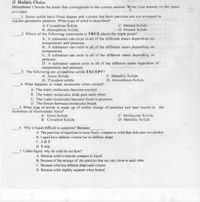
Chemistry
10th Edition
ISBN: 9781305957404
Author: Steven S. Zumdahl, Susan A. Zumdahl, Donald J. DeCoste
Publisher: Cengage Learning
expand_more
expand_more
format_list_bulleted
Concept explainers
Question
1-3

Transcribed Image Text:od nozob
II. Multiple Choice
Directions: Choose the letter that corresponds to the correct answer. Write your answer on the space
provided.
1. Some solids have fixed shapes and volume but their particles are not arranged in
regular geometric patterns. What type of solid is described?
DOLgibojo-qubo
Juoda sw ai or
C. Melted Solids
abr D. Frozen Solids
2. Which of the following statements is TRUE about the triple point?
A. Crystalline Solids
B. Amorphous Solids
ail
A. A substance can exist in all of the different states depending on AC
temperature and pressure.
B.. A substance can exist in all of the different states depending on
temperature.
C. A substance can exist in all of the different states depending on
pressure.
D. A substance cannot exist in all of the different states regardless of
temperature and pressure.
biupil is:
3. The foliowing are crystalline solids EXCEPT?
C. Metallic Solids
A. Ionic Solids
B. Covalent solids
D. Amorphous Solids
4. What happens to water molecules when cooled?
A. The water molecules become excited.
B. The water molecules slide past each other.
C. The water molecules become fixed in position.
D. The forces between molecules break.
5. What type of solids is made up of unlike charge of particles and later results in
formation of electrostatic force?
the
C. Molecular Solids
A. Ionic Solids
B. Covalent Solids
D. Metallic Solids
6. Why is liquid difficult to compress? Because
A. The particles of liquid move more freely compare to solid that slide past one another
B. Liquid have definite volume but no definite shape
C. A & B
D. B only
7. Unlike liquid, why do solid do not flow?
A. Because solid is heavier compare to liquid
B. Because of the arrange of the particles that are very close to each other
C. Because solid has definite shape and volume
D. Because solid slightly expands when heated
Expert Solution
This question has been solved!
Explore an expertly crafted, step-by-step solution for a thorough understanding of key concepts.
This is a popular solution
Trending nowThis is a popular solution!
Step by stepSolved in 2 steps with 3 images

Knowledge Booster
Learn more about
Need a deep-dive on the concept behind this application? Look no further. Learn more about this topic, chemistry and related others by exploring similar questions and additional content below.Similar questions
- STARTING AMOUNT esc C X C 2 F2 W # 3 1000 F3 ADD FACTOR x( ) $ 4 1 97.9 FS de in % 5 2 Convert 23.4 kJ to calories 2.34 x 104 t 4184 kcal 6 P 0.001 J 4.184 COMEC DOLL ANSWER & 7 9.79 × 104 cal 00 8 RESET FO 2 23.4 ( 5590 A FIT 120 Jan 21 del +arrow_forwardWhich of the following molecules are antihistamines? Check all that apply. ► View Available Hint(s) U 0 H-N L CH,CH,NH,* But CH–O–CH,CH,−N CH,CH,NHNH, H 4arrow_forwardNeed help with homeworkarrow_forward
- 45. | You find that if you hang a 1.25 kg weight from a vertical spring, it stretches 3.75 cm. (a) What is the force constant of this spring in N/m? (b) How much mass should you hang from the spring so it will stretch by 8.13 cm from its original, unstretched length?arrow_forwardThe below drawing shows the equilibrium vapor pressure of a pure liquid. Select the drawing that represents the equilibrium vapor pressure when a nonvolatile solute is dissolved in the liquid? a)arrow_forwardWhich of the following is a (011) plane? (A) (B) (C) y A C None of the above B. O OOarrow_forward
arrow_back_ios
arrow_forward_ios
Recommended textbooks for you
 ChemistryChemistryISBN:9781305957404Author:Steven S. Zumdahl, Susan A. Zumdahl, Donald J. DeCostePublisher:Cengage Learning
ChemistryChemistryISBN:9781305957404Author:Steven S. Zumdahl, Susan A. Zumdahl, Donald J. DeCostePublisher:Cengage Learning ChemistryChemistryISBN:9781259911156Author:Raymond Chang Dr., Jason Overby ProfessorPublisher:McGraw-Hill Education
ChemistryChemistryISBN:9781259911156Author:Raymond Chang Dr., Jason Overby ProfessorPublisher:McGraw-Hill Education Principles of Instrumental AnalysisChemistryISBN:9781305577213Author:Douglas A. Skoog, F. James Holler, Stanley R. CrouchPublisher:Cengage Learning
Principles of Instrumental AnalysisChemistryISBN:9781305577213Author:Douglas A. Skoog, F. James Holler, Stanley R. CrouchPublisher:Cengage Learning Organic ChemistryChemistryISBN:9780078021558Author:Janice Gorzynski Smith Dr.Publisher:McGraw-Hill Education
Organic ChemistryChemistryISBN:9780078021558Author:Janice Gorzynski Smith Dr.Publisher:McGraw-Hill Education Chemistry: Principles and ReactionsChemistryISBN:9781305079373Author:William L. Masterton, Cecile N. HurleyPublisher:Cengage Learning
Chemistry: Principles and ReactionsChemistryISBN:9781305079373Author:William L. Masterton, Cecile N. HurleyPublisher:Cengage Learning Elementary Principles of Chemical Processes, Bind...ChemistryISBN:9781118431221Author:Richard M. Felder, Ronald W. Rousseau, Lisa G. BullardPublisher:WILEY
Elementary Principles of Chemical Processes, Bind...ChemistryISBN:9781118431221Author:Richard M. Felder, Ronald W. Rousseau, Lisa G. BullardPublisher:WILEY

Chemistry
Chemistry
ISBN:9781305957404
Author:Steven S. Zumdahl, Susan A. Zumdahl, Donald J. DeCoste
Publisher:Cengage Learning

Chemistry
Chemistry
ISBN:9781259911156
Author:Raymond Chang Dr., Jason Overby Professor
Publisher:McGraw-Hill Education

Principles of Instrumental Analysis
Chemistry
ISBN:9781305577213
Author:Douglas A. Skoog, F. James Holler, Stanley R. Crouch
Publisher:Cengage Learning

Organic Chemistry
Chemistry
ISBN:9780078021558
Author:Janice Gorzynski Smith Dr.
Publisher:McGraw-Hill Education

Chemistry: Principles and Reactions
Chemistry
ISBN:9781305079373
Author:William L. Masterton, Cecile N. Hurley
Publisher:Cengage Learning

Elementary Principles of Chemical Processes, Bind...
Chemistry
ISBN:9781118431221
Author:Richard M. Felder, Ronald W. Rousseau, Lisa G. Bullard
Publisher:WILEY